Cross-Cultural Management Report: Leadership, Culture, HRM Analysis
VerifiedAdded on 2022/12/27
|11
|3048
|95
Report
AI Summary
This report provides a comprehensive analysis of cross-cultural management principles within the context of a Hydro Generation project in Tanzania. It begins with an introduction to cross-cultural management and its importance in a globalized business environment, followed by an examination of organizational culture using Edgar Schein's model, focusing on artifacts, values, and assumed values, and addressing challenges such as maintaining a healthy organizational culture and ensuring employee involvement. The report then delves into organizational structure, comparing hierarchical, functional, divisional, and flat structures, and analyzes the conflicts arising in the Hydro Generation project and provides solutions. Finally, it explores the role of motivation and human resource management, including Herzberg's two-factor theory, to enhance employee performance. The report offers recommendations based on the analysis to improve cross-cultural management practices within the organization.
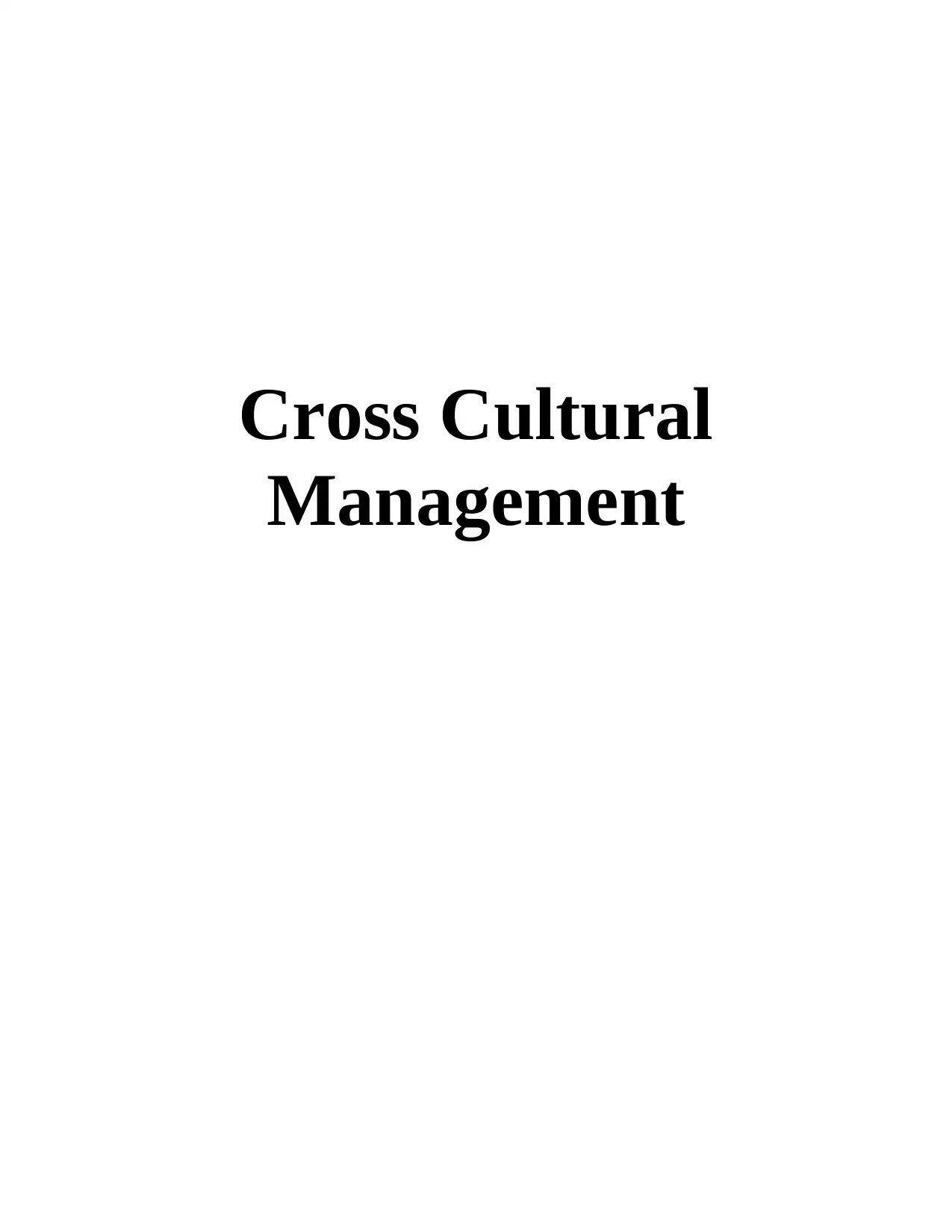
Cross Cultural
Management
Management
Paraphrase This Document
Need a fresh take? Get an instant paraphrase of this document with our AI Paraphraser
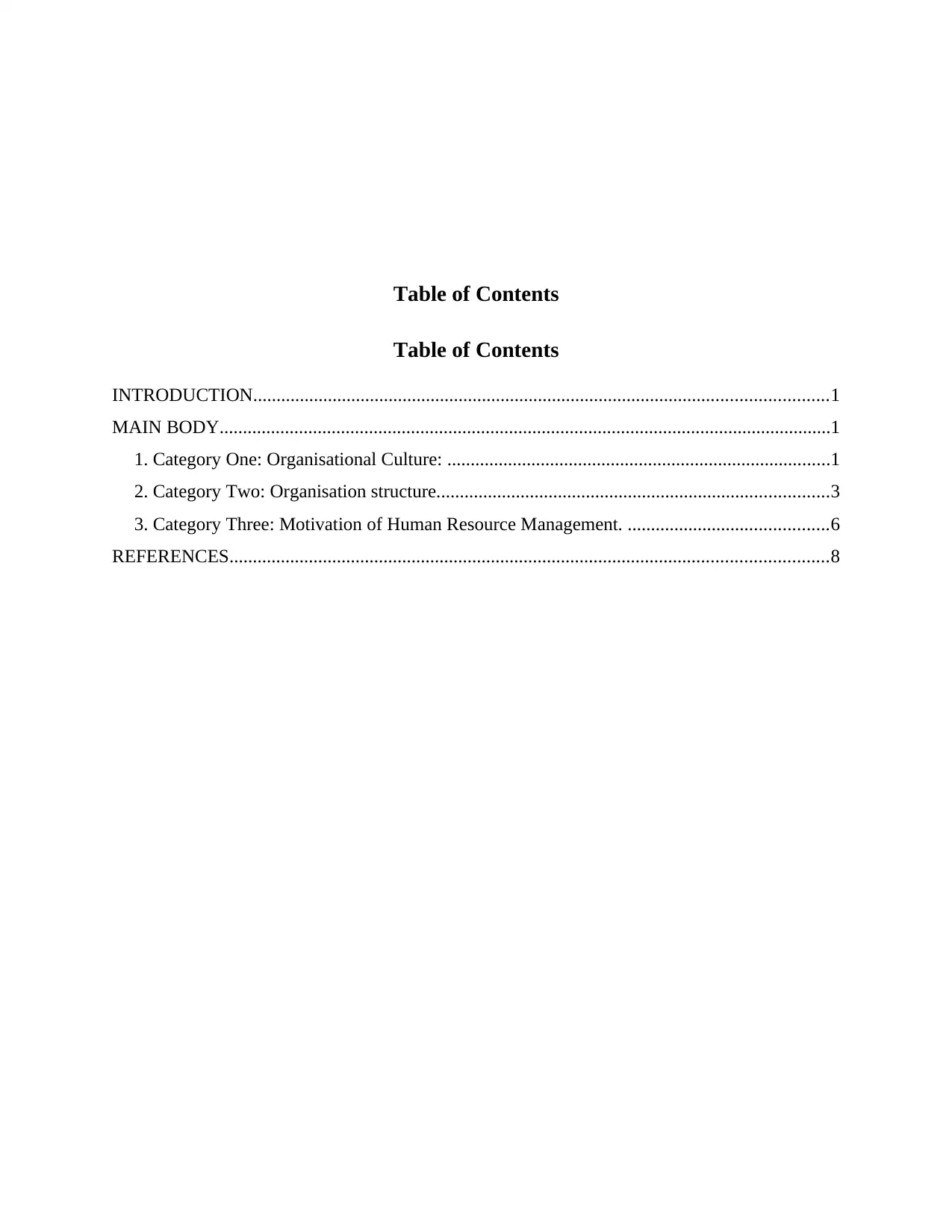
Table of Contents
Table of Contents
INTRODUCTION...........................................................................................................................1
MAIN BODY...................................................................................................................................1
1. Category One: Organisational Culture: ..................................................................................1
2. Category Two: Organisation structure....................................................................................3
3. Category Three: Motivation of Human Resource Management. ...........................................6
REFERENCES................................................................................................................................8
Table of Contents
INTRODUCTION...........................................................................................................................1
MAIN BODY...................................................................................................................................1
1. Category One: Organisational Culture: ..................................................................................1
2. Category Two: Organisation structure....................................................................................3
3. Category Three: Motivation of Human Resource Management. ...........................................6
REFERENCES................................................................................................................................8
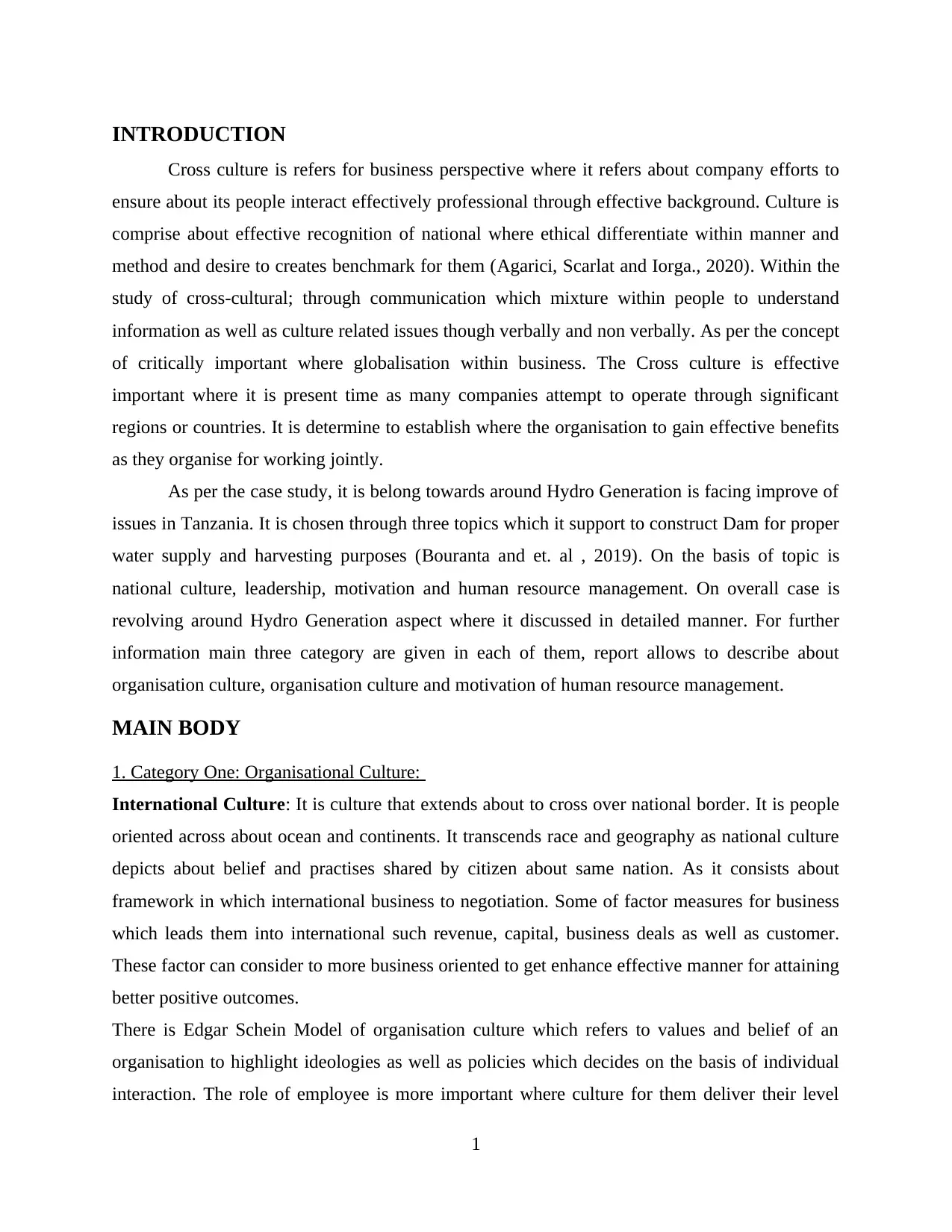
INTRODUCTION
Cross culture is refers for business perspective where it refers about company efforts to
ensure about its people interact effectively professional through effective background. Culture is
comprise about effective recognition of national where ethical differentiate within manner and
method and desire to creates benchmark for them (Agarici, Scarlat and Iorga., 2020). Within the
study of cross-cultural; through communication which mixture within people to understand
information as well as culture related issues though verbally and non verbally. As per the concept
of critically important where globalisation within business. The Cross culture is effective
important where it is present time as many companies attempt to operate through significant
regions or countries. It is determine to establish where the organisation to gain effective benefits
as they organise for working jointly.
As per the case study, it is belong towards around Hydro Generation is facing improve of
issues in Tanzania. It is chosen through three topics which it support to construct Dam for proper
water supply and harvesting purposes (Bouranta and et. al , 2019). On the basis of topic is
national culture, leadership, motivation and human resource management. On overall case is
revolving around Hydro Generation aspect where it discussed in detailed manner. For further
information main three category are given in each of them, report allows to describe about
organisation culture, organisation culture and motivation of human resource management.
MAIN BODY
1. Category One: Organisational Culture:
International Culture: It is culture that extends about to cross over national border. It is people
oriented across about ocean and continents. It transcends race and geography as national culture
depicts about belief and practises shared by citizen about same nation. As it consists about
framework in which international business to negotiation. Some of factor measures for business
which leads them into international such revenue, capital, business deals as well as customer.
These factor can consider to more business oriented to get enhance effective manner for attaining
better positive outcomes.
There is Edgar Schein Model of organisation culture which refers to values and belief of an
organisation to highlight ideologies as well as policies which decides on the basis of individual
interaction. The role of employee is more important where culture for them deliver their level
1
Cross culture is refers for business perspective where it refers about company efforts to
ensure about its people interact effectively professional through effective background. Culture is
comprise about effective recognition of national where ethical differentiate within manner and
method and desire to creates benchmark for them (Agarici, Scarlat and Iorga., 2020). Within the
study of cross-cultural; through communication which mixture within people to understand
information as well as culture related issues though verbally and non verbally. As per the concept
of critically important where globalisation within business. The Cross culture is effective
important where it is present time as many companies attempt to operate through significant
regions or countries. It is determine to establish where the organisation to gain effective benefits
as they organise for working jointly.
As per the case study, it is belong towards around Hydro Generation is facing improve of
issues in Tanzania. It is chosen through three topics which it support to construct Dam for proper
water supply and harvesting purposes (Bouranta and et. al , 2019). On the basis of topic is
national culture, leadership, motivation and human resource management. On overall case is
revolving around Hydro Generation aspect where it discussed in detailed manner. For further
information main three category are given in each of them, report allows to describe about
organisation culture, organisation culture and motivation of human resource management.
MAIN BODY
1. Category One: Organisational Culture:
International Culture: It is culture that extends about to cross over national border. It is people
oriented across about ocean and continents. It transcends race and geography as national culture
depicts about belief and practises shared by citizen about same nation. As it consists about
framework in which international business to negotiation. Some of factor measures for business
which leads them into international such revenue, capital, business deals as well as customer.
These factor can consider to more business oriented to get enhance effective manner for attaining
better positive outcomes.
There is Edgar Schein Model of organisation culture which refers to values and belief of an
organisation to highlight ideologies as well as policies which decides on the basis of individual
interaction. The role of employee is more important where culture for them deliver their level
1
⊘ This is a preview!⊘
Do you want full access?
Subscribe today to unlock all pages.

Trusted by 1+ million students worldwide
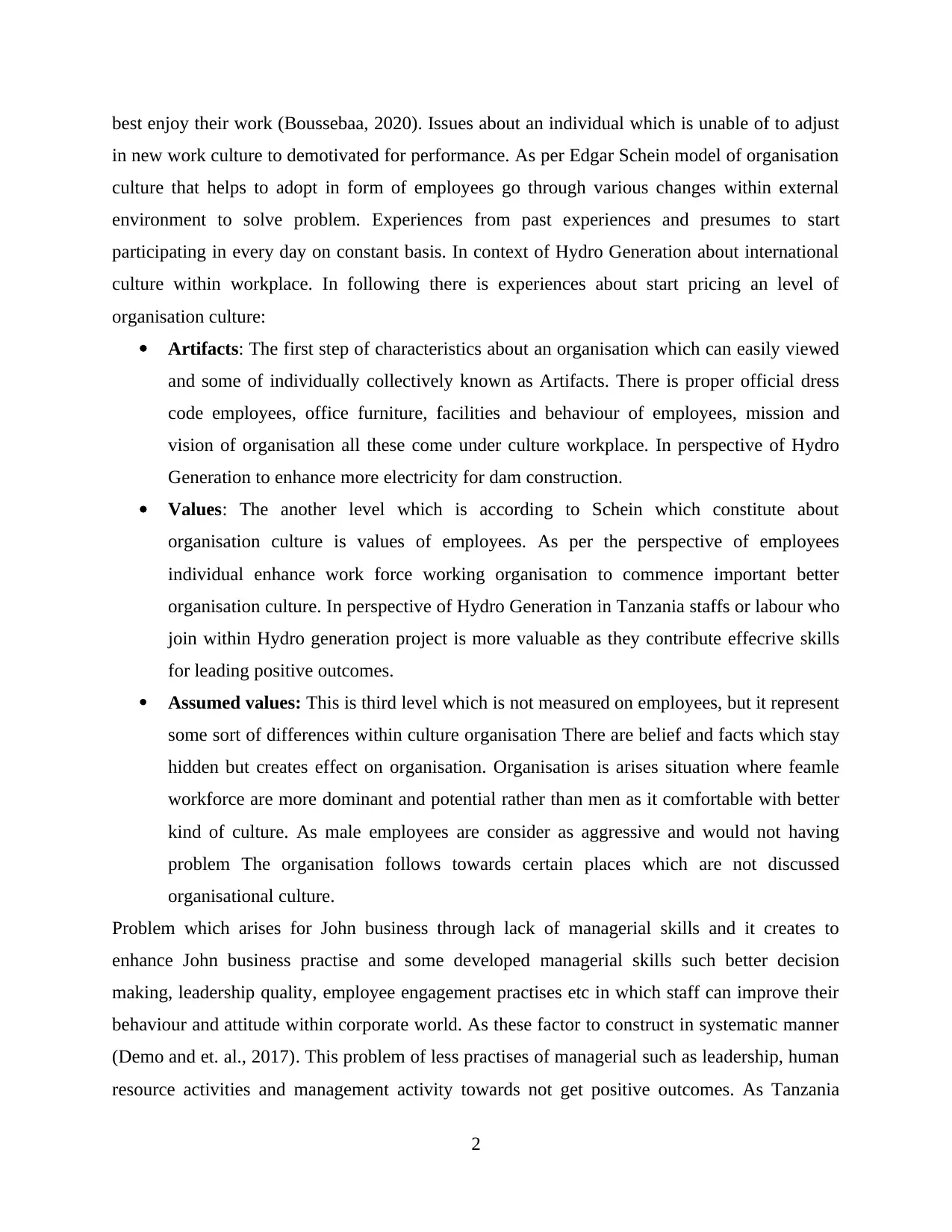
best enjoy their work (Boussebaa, 2020). Issues about an individual which is unable of to adjust
in new work culture to demotivated for performance. As per Edgar Schein model of organisation
culture that helps to adopt in form of employees go through various changes within external
environment to solve problem. Experiences from past experiences and presumes to start
participating in every day on constant basis. In context of Hydro Generation about international
culture within workplace. In following there is experiences about start pricing an level of
organisation culture:
Artifacts: The first step of characteristics about an organisation which can easily viewed
and some of individually collectively known as Artifacts. There is proper official dress
code employees, office furniture, facilities and behaviour of employees, mission and
vision of organisation all these come under culture workplace. In perspective of Hydro
Generation to enhance more electricity for dam construction.
Values: The another level which is according to Schein which constitute about
organisation culture is values of employees. As per the perspective of employees
individual enhance work force working organisation to commence important better
organisation culture. In perspective of Hydro Generation in Tanzania staffs or labour who
join within Hydro generation project is more valuable as they contribute effecrive skills
for leading positive outcomes.
Assumed values: This is third level which is not measured on employees, but it represent
some sort of differences within culture organisation There are belief and facts which stay
hidden but creates effect on organisation. Organisation is arises situation where feamle
workforce are more dominant and potential rather than men as it comfortable with better
kind of culture. As male employees are consider as aggressive and would not having
problem The organisation follows towards certain places which are not discussed
organisational culture.
Problem which arises for John business through lack of managerial skills and it creates to
enhance John business practise and some developed managerial skills such better decision
making, leadership quality, employee engagement practises etc in which staff can improve their
behaviour and attitude within corporate world. As these factor to construct in systematic manner
(Demo and et. al., 2017). This problem of less practises of managerial such as leadership, human
resource activities and management activity towards not get positive outcomes. As Tanzania
2
in new work culture to demotivated for performance. As per Edgar Schein model of organisation
culture that helps to adopt in form of employees go through various changes within external
environment to solve problem. Experiences from past experiences and presumes to start
participating in every day on constant basis. In context of Hydro Generation about international
culture within workplace. In following there is experiences about start pricing an level of
organisation culture:
Artifacts: The first step of characteristics about an organisation which can easily viewed
and some of individually collectively known as Artifacts. There is proper official dress
code employees, office furniture, facilities and behaviour of employees, mission and
vision of organisation all these come under culture workplace. In perspective of Hydro
Generation to enhance more electricity for dam construction.
Values: The another level which is according to Schein which constitute about
organisation culture is values of employees. As per the perspective of employees
individual enhance work force working organisation to commence important better
organisation culture. In perspective of Hydro Generation in Tanzania staffs or labour who
join within Hydro generation project is more valuable as they contribute effecrive skills
for leading positive outcomes.
Assumed values: This is third level which is not measured on employees, but it represent
some sort of differences within culture organisation There are belief and facts which stay
hidden but creates effect on organisation. Organisation is arises situation where feamle
workforce are more dominant and potential rather than men as it comfortable with better
kind of culture. As male employees are consider as aggressive and would not having
problem The organisation follows towards certain places which are not discussed
organisational culture.
Problem which arises for John business through lack of managerial skills and it creates to
enhance John business practise and some developed managerial skills such better decision
making, leadership quality, employee engagement practises etc in which staff can improve their
behaviour and attitude within corporate world. As these factor to construct in systematic manner
(Demo and et. al., 2017). This problem of less practises of managerial such as leadership, human
resource activities and management activity towards not get positive outcomes. As Tanzania
2
Paraphrase This Document
Need a fresh take? Get an instant paraphrase of this document with our AI Paraphraser

where it commence religions for Hydro Generation in falls for investigate optimum solution. To
maintain organisational culture it is mist to study about international market where it contains
their own rules and regulation for creates positive base of outcomes. But some of challenges are
defined as in context of Organisation culture which faces by Hydro generation in Tanzania.
Challenge 1: The major and common challenge is maintain organisation current culture
which ensure about organisation healthy or goodwill. To maintain this, there is objective
is how organisation can compete within competitive marketplace.
Challenge 2: Reinforcing towards commence about reinforcing towards constantly
through out company which measure values and ethics for general work that must
provide in Hydro generation on constant days (D'Iribarne and et. al., 2020). It avoid
adapting for organisational culture to any given situation or selective in business talking
terms.
Challenge 3: The organisational culture must involves overall all employees, it is
emerged that build team(Hao, Farooq and Sun, 2018). The culture need to be assigned
within natural to ensure everyone observe to be part of process. To convince overall
team is quite difficult as because every one having their own perception to making
decision which develop their engagement.
2. Category Two: Organisation structure.
Organisation structure is type of system that allows simple outlines about certain activities that
are monitored and guided to attaining specific goal and objective for organisation. The activities
are driven systematic rules, roles and responsibilities regarding within individual people or
department where they follows specifically job role. In following there organisation structure
such as:
3
maintain organisational culture it is mist to study about international market where it contains
their own rules and regulation for creates positive base of outcomes. But some of challenges are
defined as in context of Organisation culture which faces by Hydro generation in Tanzania.
Challenge 1: The major and common challenge is maintain organisation current culture
which ensure about organisation healthy or goodwill. To maintain this, there is objective
is how organisation can compete within competitive marketplace.
Challenge 2: Reinforcing towards commence about reinforcing towards constantly
through out company which measure values and ethics for general work that must
provide in Hydro generation on constant days (D'Iribarne and et. al., 2020). It avoid
adapting for organisational culture to any given situation or selective in business talking
terms.
Challenge 3: The organisational culture must involves overall all employees, it is
emerged that build team(Hao, Farooq and Sun, 2018). The culture need to be assigned
within natural to ensure everyone observe to be part of process. To convince overall
team is quite difficult as because every one having their own perception to making
decision which develop their engagement.
2. Category Two: Organisation structure.
Organisation structure is type of system that allows simple outlines about certain activities that
are monitored and guided to attaining specific goal and objective for organisation. The activities
are driven systematic rules, roles and responsibilities regarding within individual people or
department where they follows specifically job role. In following there organisation structure
such as:
3
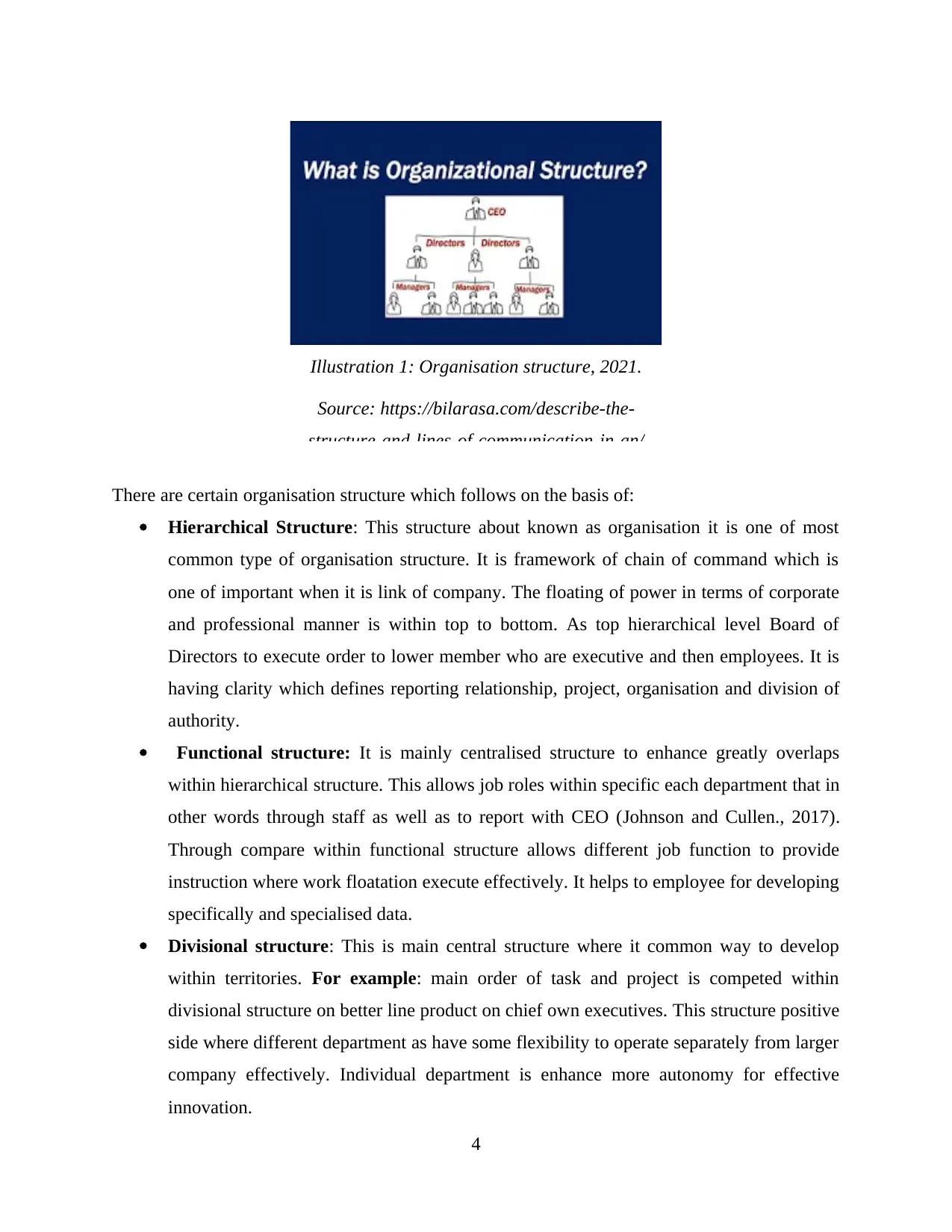
There are certain organisation structure which follows on the basis of:
Hierarchical Structure: This structure about known as organisation it is one of most
common type of organisation structure. It is framework of chain of command which is
one of important when it is link of company. The floating of power in terms of corporate
and professional manner is within top to bottom. As top hierarchical level Board of
Directors to execute order to lower member who are executive and then employees. It is
having clarity which defines reporting relationship, project, organisation and division of
authority.
Functional structure: It is mainly centralised structure to enhance greatly overlaps
within hierarchical structure. This allows job roles within specific each department that in
other words through staff as well as to report with CEO (Johnson and Cullen., 2017).
Through compare within functional structure allows different job function to provide
instruction where work floatation execute effectively. It helps to employee for developing
specifically and specialised data.
Divisional structure: This is main central structure where it common way to develop
within territories. For example: main order of task and project is competed within
divisional structure on better line product on chief own executives. This structure positive
side where different department as have some flexibility to operate separately from larger
company effectively. Individual department is enhance more autonomy for effective
innovation.
4
Illustration 1: Organisation structure, 2021.
Source: https://bilarasa.com/describe-the-
structure-and-lines-of-communication-in-an/
Hierarchical Structure: This structure about known as organisation it is one of most
common type of organisation structure. It is framework of chain of command which is
one of important when it is link of company. The floating of power in terms of corporate
and professional manner is within top to bottom. As top hierarchical level Board of
Directors to execute order to lower member who are executive and then employees. It is
having clarity which defines reporting relationship, project, organisation and division of
authority.
Functional structure: It is mainly centralised structure to enhance greatly overlaps
within hierarchical structure. This allows job roles within specific each department that in
other words through staff as well as to report with CEO (Johnson and Cullen., 2017).
Through compare within functional structure allows different job function to provide
instruction where work floatation execute effectively. It helps to employee for developing
specifically and specialised data.
Divisional structure: This is main central structure where it common way to develop
within territories. For example: main order of task and project is competed within
divisional structure on better line product on chief own executives. This structure positive
side where different department as have some flexibility to operate separately from larger
company effectively. Individual department is enhance more autonomy for effective
innovation.
4
Illustration 1: Organisation structure, 2021.
Source: https://bilarasa.com/describe-the-
structure-and-lines-of-communication-in-an/
⊘ This is a preview!⊘
Do you want full access?
Subscribe today to unlock all pages.

Trusted by 1+ million students worldwide
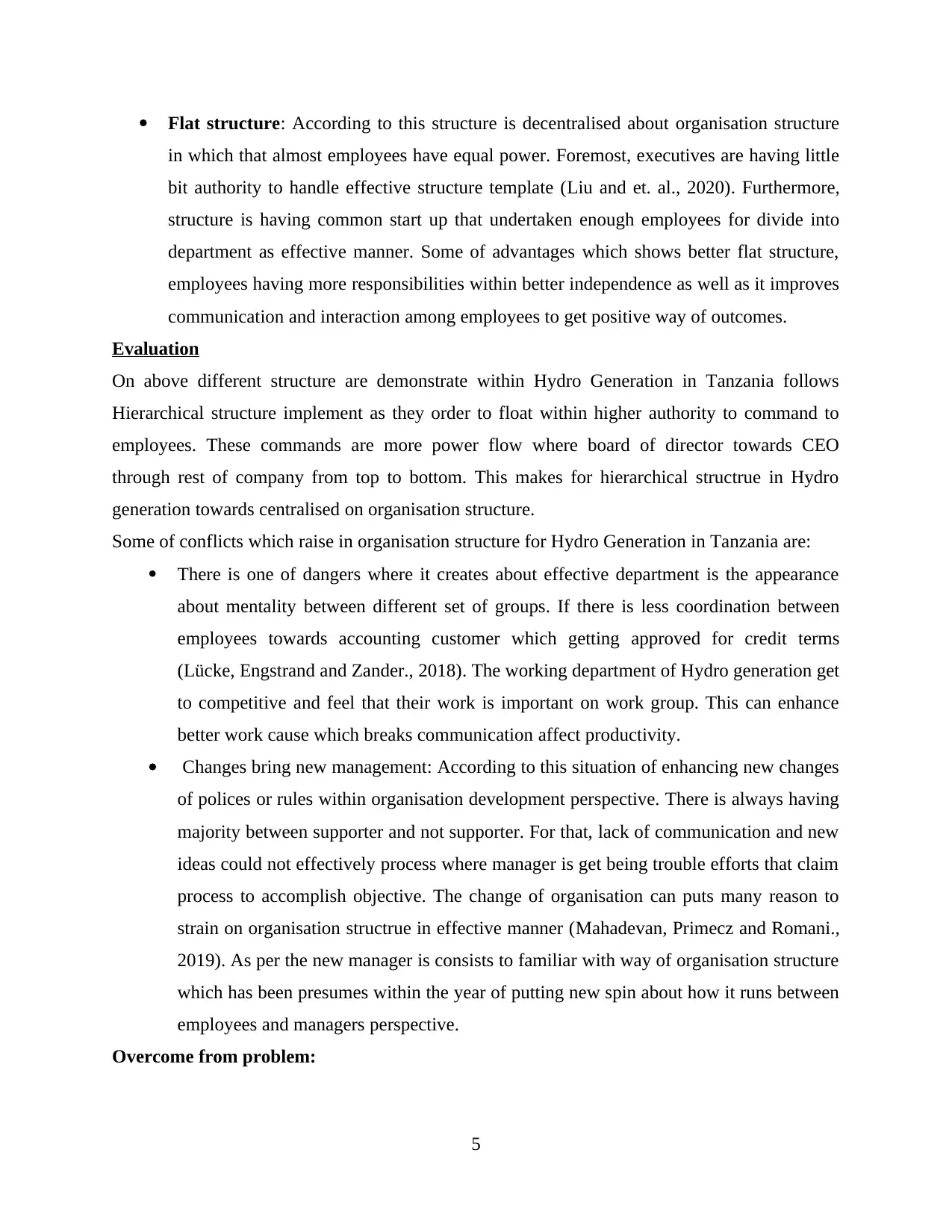
Flat structure: According to this structure is decentralised about organisation structure
in which that almost employees have equal power. Foremost, executives are having little
bit authority to handle effective structure template (Liu and et. al., 2020). Furthermore,
structure is having common start up that undertaken enough employees for divide into
department as effective manner. Some of advantages which shows better flat structure,
employees having more responsibilities within better independence as well as it improves
communication and interaction among employees to get positive way of outcomes.
Evaluation
On above different structure are demonstrate within Hydro Generation in Tanzania follows
Hierarchical structure implement as they order to float within higher authority to command to
employees. These commands are more power flow where board of director towards CEO
through rest of company from top to bottom. This makes for hierarchical structrue in Hydro
generation towards centralised on organisation structure.
Some of conflicts which raise in organisation structure for Hydro Generation in Tanzania are:
There is one of dangers where it creates about effective department is the appearance
about mentality between different set of groups. If there is less coordination between
employees towards accounting customer which getting approved for credit terms
(Lücke, Engstrand and Zander., 2018). The working department of Hydro generation get
to competitive and feel that their work is important on work group. This can enhance
better work cause which breaks communication affect productivity.
Changes bring new management: According to this situation of enhancing new changes
of polices or rules within organisation development perspective. There is always having
majority between supporter and not supporter. For that, lack of communication and new
ideas could not effectively process where manager is get being trouble efforts that claim
process to accomplish objective. The change of organisation can puts many reason to
strain on organisation structrue in effective manner (Mahadevan, Primecz and Romani.,
2019). As per the new manager is consists to familiar with way of organisation structure
which has been presumes within the year of putting new spin about how it runs between
employees and managers perspective.
Overcome from problem:
5
in which that almost employees have equal power. Foremost, executives are having little
bit authority to handle effective structure template (Liu and et. al., 2020). Furthermore,
structure is having common start up that undertaken enough employees for divide into
department as effective manner. Some of advantages which shows better flat structure,
employees having more responsibilities within better independence as well as it improves
communication and interaction among employees to get positive way of outcomes.
Evaluation
On above different structure are demonstrate within Hydro Generation in Tanzania follows
Hierarchical structure implement as they order to float within higher authority to command to
employees. These commands are more power flow where board of director towards CEO
through rest of company from top to bottom. This makes for hierarchical structrue in Hydro
generation towards centralised on organisation structure.
Some of conflicts which raise in organisation structure for Hydro Generation in Tanzania are:
There is one of dangers where it creates about effective department is the appearance
about mentality between different set of groups. If there is less coordination between
employees towards accounting customer which getting approved for credit terms
(Lücke, Engstrand and Zander., 2018). The working department of Hydro generation get
to competitive and feel that their work is important on work group. This can enhance
better work cause which breaks communication affect productivity.
Changes bring new management: According to this situation of enhancing new changes
of polices or rules within organisation development perspective. There is always having
majority between supporter and not supporter. For that, lack of communication and new
ideas could not effectively process where manager is get being trouble efforts that claim
process to accomplish objective. The change of organisation can puts many reason to
strain on organisation structrue in effective manner (Mahadevan, Primecz and Romani.,
2019). As per the new manager is consists to familiar with way of organisation structure
which has been presumes within the year of putting new spin about how it runs between
employees and managers perspective.
Overcome from problem:
5
Paraphrase This Document
Need a fresh take? Get an instant paraphrase of this document with our AI Paraphraser
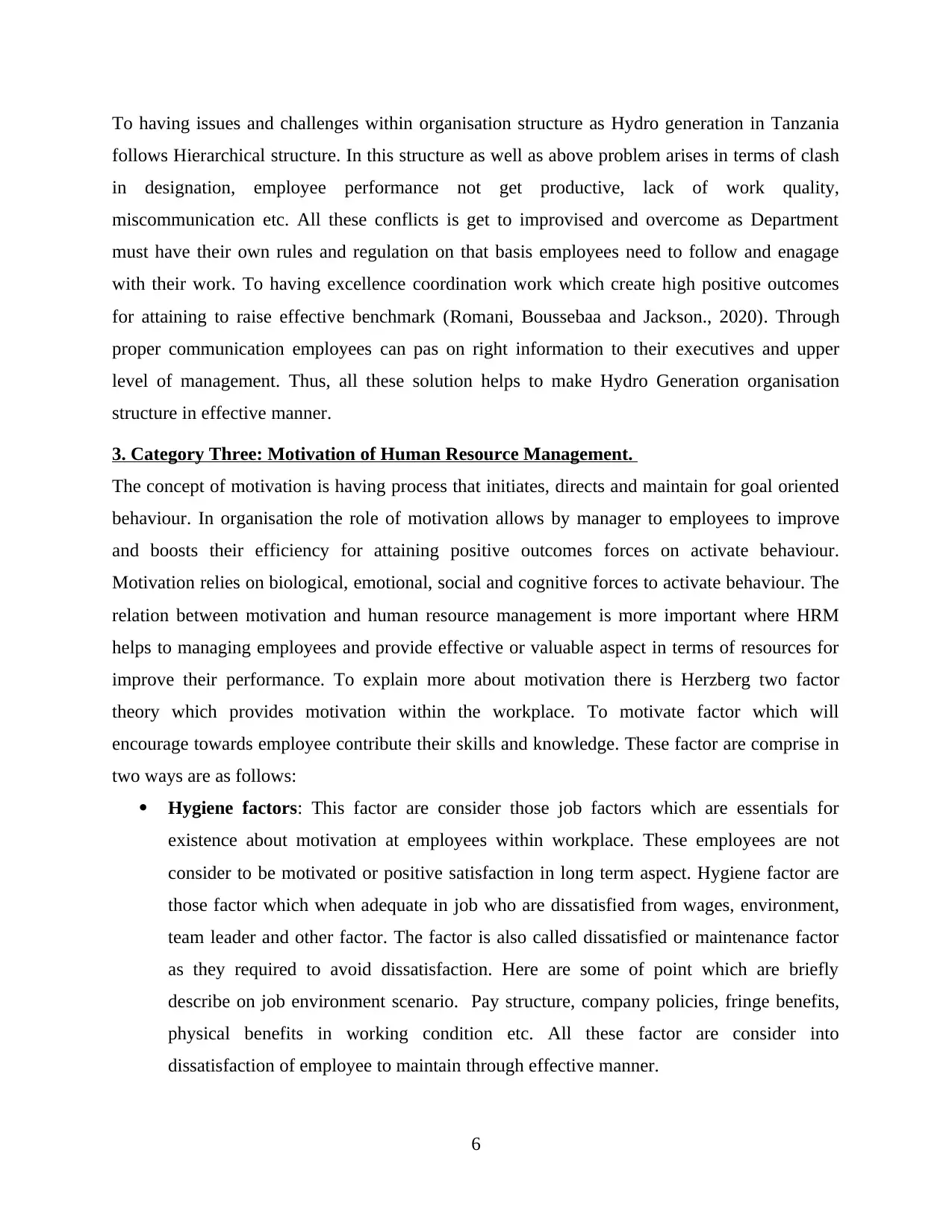
To having issues and challenges within organisation structure as Hydro generation in Tanzania
follows Hierarchical structure. In this structure as well as above problem arises in terms of clash
in designation, employee performance not get productive, lack of work quality,
miscommunication etc. All these conflicts is get to improvised and overcome as Department
must have their own rules and regulation on that basis employees need to follow and enagage
with their work. To having excellence coordination work which create high positive outcomes
for attaining to raise effective benchmark (Romani, Boussebaa and Jackson., 2020). Through
proper communication employees can pas on right information to their executives and upper
level of management. Thus, all these solution helps to make Hydro Generation organisation
structure in effective manner.
3. Category Three: Motivation of Human Resource Management.
The concept of motivation is having process that initiates, directs and maintain for goal oriented
behaviour. In organisation the role of motivation allows by manager to employees to improve
and boosts their efficiency for attaining positive outcomes forces on activate behaviour.
Motivation relies on biological, emotional, social and cognitive forces to activate behaviour. The
relation between motivation and human resource management is more important where HRM
helps to managing employees and provide effective or valuable aspect in terms of resources for
improve their performance. To explain more about motivation there is Herzberg two factor
theory which provides motivation within the workplace. To motivate factor which will
encourage towards employee contribute their skills and knowledge. These factor are comprise in
two ways are as follows:
Hygiene factors: This factor are consider those job factors which are essentials for
existence about motivation at employees within workplace. These employees are not
consider to be motivated or positive satisfaction in long term aspect. Hygiene factor are
those factor which when adequate in job who are dissatisfied from wages, environment,
team leader and other factor. The factor is also called dissatisfied or maintenance factor
as they required to avoid dissatisfaction. Here are some of point which are briefly
describe on job environment scenario. Pay structure, company policies, fringe benefits,
physical benefits in working condition etc. All these factor are consider into
dissatisfaction of employee to maintain through effective manner.
6
follows Hierarchical structure. In this structure as well as above problem arises in terms of clash
in designation, employee performance not get productive, lack of work quality,
miscommunication etc. All these conflicts is get to improvised and overcome as Department
must have their own rules and regulation on that basis employees need to follow and enagage
with their work. To having excellence coordination work which create high positive outcomes
for attaining to raise effective benchmark (Romani, Boussebaa and Jackson., 2020). Through
proper communication employees can pas on right information to their executives and upper
level of management. Thus, all these solution helps to make Hydro Generation organisation
structure in effective manner.
3. Category Three: Motivation of Human Resource Management.
The concept of motivation is having process that initiates, directs and maintain for goal oriented
behaviour. In organisation the role of motivation allows by manager to employees to improve
and boosts their efficiency for attaining positive outcomes forces on activate behaviour.
Motivation relies on biological, emotional, social and cognitive forces to activate behaviour. The
relation between motivation and human resource management is more important where HRM
helps to managing employees and provide effective or valuable aspect in terms of resources for
improve their performance. To explain more about motivation there is Herzberg two factor
theory which provides motivation within the workplace. To motivate factor which will
encourage towards employee contribute their skills and knowledge. These factor are comprise in
two ways are as follows:
Hygiene factors: This factor are consider those job factors which are essentials for
existence about motivation at employees within workplace. These employees are not
consider to be motivated or positive satisfaction in long term aspect. Hygiene factor are
those factor which when adequate in job who are dissatisfied from wages, environment,
team leader and other factor. The factor is also called dissatisfied or maintenance factor
as they required to avoid dissatisfaction. Here are some of point which are briefly
describe on job environment scenario. Pay structure, company policies, fringe benefits,
physical benefits in working condition etc. All these factor are consider into
dissatisfaction of employee to maintain through effective manner.
6
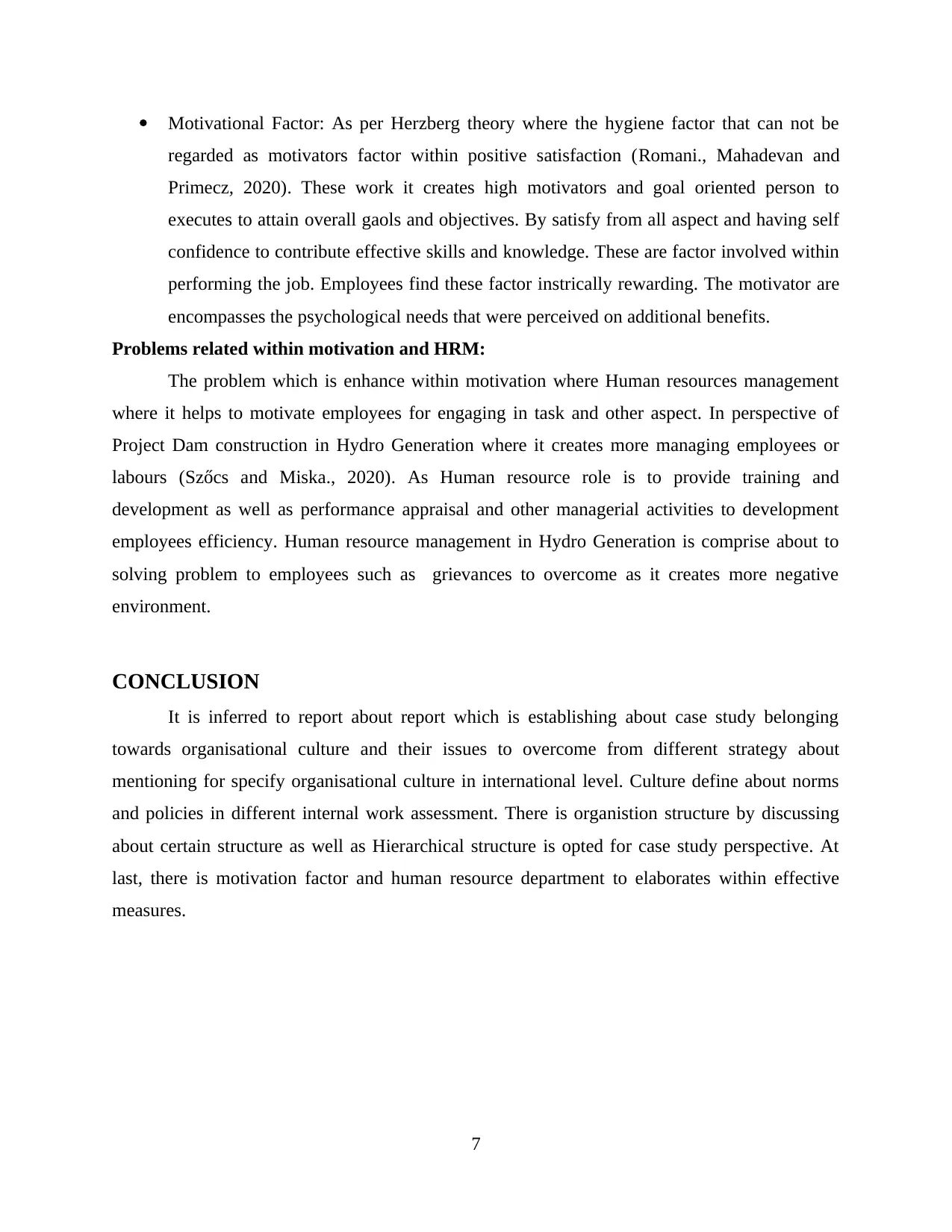
Motivational Factor: As per Herzberg theory where the hygiene factor that can not be
regarded as motivators factor within positive satisfaction (Romani., Mahadevan and
Primecz, 2020). These work it creates high motivators and goal oriented person to
executes to attain overall gaols and objectives. By satisfy from all aspect and having self
confidence to contribute effective skills and knowledge. These are factor involved within
performing the job. Employees find these factor instrically rewarding. The motivator are
encompasses the psychological needs that were perceived on additional benefits.
Problems related within motivation and HRM:
The problem which is enhance within motivation where Human resources management
where it helps to motivate employees for engaging in task and other aspect. In perspective of
Project Dam construction in Hydro Generation where it creates more managing employees or
labours (Szőcs and Miska., 2020). As Human resource role is to provide training and
development as well as performance appraisal and other managerial activities to development
employees efficiency. Human resource management in Hydro Generation is comprise about to
solving problem to employees such as grievances to overcome as it creates more negative
environment.
CONCLUSION
It is inferred to report about report which is establishing about case study belonging
towards organisational culture and their issues to overcome from different strategy about
mentioning for specify organisational culture in international level. Culture define about norms
and policies in different internal work assessment. There is organistion structure by discussing
about certain structure as well as Hierarchical structure is opted for case study perspective. At
last, there is motivation factor and human resource department to elaborates within effective
measures.
7
regarded as motivators factor within positive satisfaction (Romani., Mahadevan and
Primecz, 2020). These work it creates high motivators and goal oriented person to
executes to attain overall gaols and objectives. By satisfy from all aspect and having self
confidence to contribute effective skills and knowledge. These are factor involved within
performing the job. Employees find these factor instrically rewarding. The motivator are
encompasses the psychological needs that were perceived on additional benefits.
Problems related within motivation and HRM:
The problem which is enhance within motivation where Human resources management
where it helps to motivate employees for engaging in task and other aspect. In perspective of
Project Dam construction in Hydro Generation where it creates more managing employees or
labours (Szőcs and Miska., 2020). As Human resource role is to provide training and
development as well as performance appraisal and other managerial activities to development
employees efficiency. Human resource management in Hydro Generation is comprise about to
solving problem to employees such as grievances to overcome as it creates more negative
environment.
CONCLUSION
It is inferred to report about report which is establishing about case study belonging
towards organisational culture and their issues to overcome from different strategy about
mentioning for specify organisational culture in international level. Culture define about norms
and policies in different internal work assessment. There is organistion structure by discussing
about certain structure as well as Hierarchical structure is opted for case study perspective. At
last, there is motivation factor and human resource department to elaborates within effective
measures.
7
⊘ This is a preview!⊘
Do you want full access?
Subscribe today to unlock all pages.

Trusted by 1+ million students worldwide
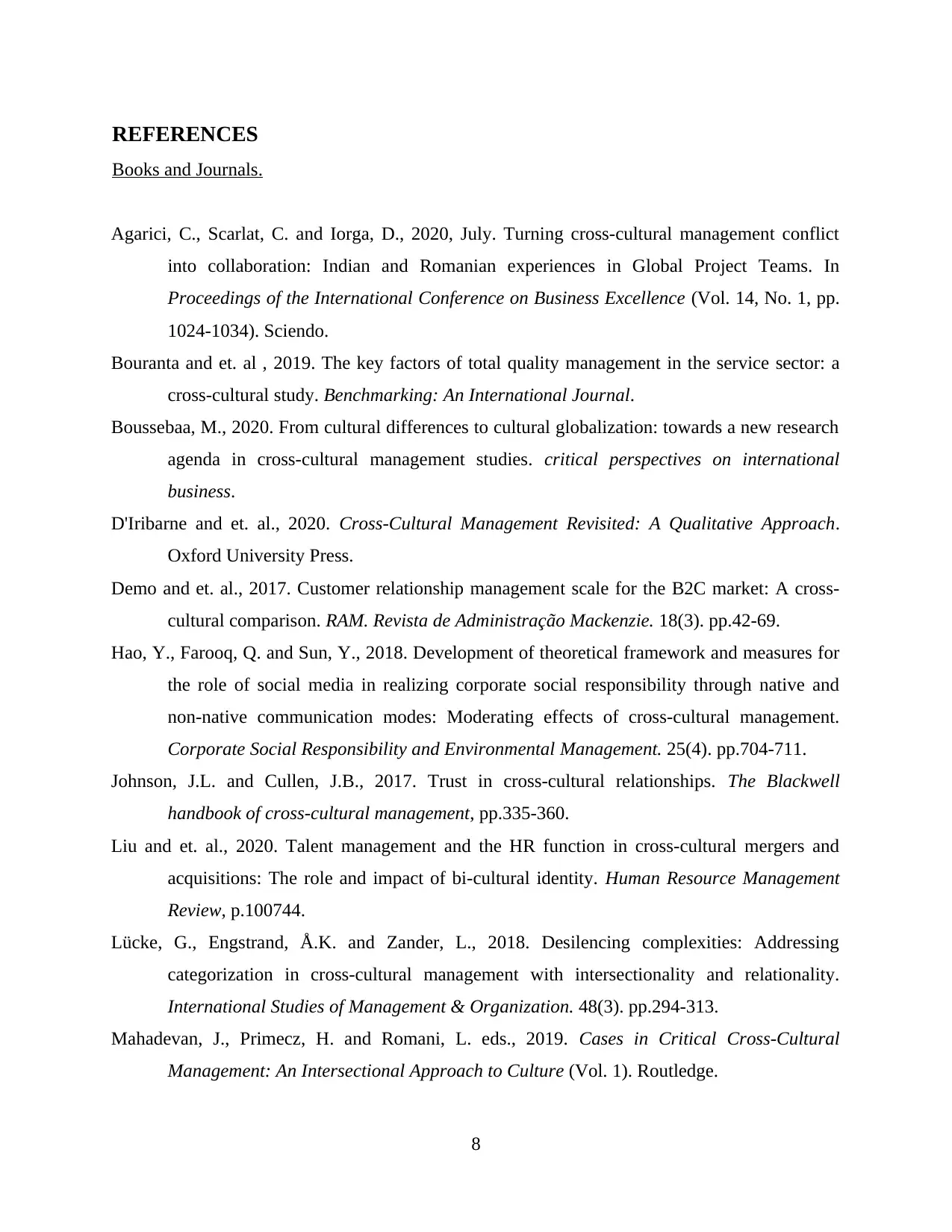
REFERENCES
Books and Journals.
Agarici, C., Scarlat, C. and Iorga, D., 2020, July. Turning cross-cultural management conflict
into collaboration: Indian and Romanian experiences in Global Project Teams. In
Proceedings of the International Conference on Business Excellence (Vol. 14, No. 1, pp.
1024-1034). Sciendo.
Bouranta and et. al , 2019. The key factors of total quality management in the service sector: a
cross-cultural study. Benchmarking: An International Journal.
Boussebaa, M., 2020. From cultural differences to cultural globalization: towards a new research
agenda in cross-cultural management studies. critical perspectives on international
business.
D'Iribarne and et. al., 2020. Cross-Cultural Management Revisited: A Qualitative Approach.
Oxford University Press.
Demo and et. al., 2017. Customer relationship management scale for the B2C market: A cross-
cultural comparison. RAM. Revista de Administração Mackenzie. 18(3). pp.42-69.
Hao, Y., Farooq, Q. and Sun, Y., 2018. Development of theoretical framework and measures for
the role of social media in realizing corporate social responsibility through native and
non‐native communication modes: Moderating effects of cross‐cultural management.
Corporate Social Responsibility and Environmental Management. 25(4). pp.704-711.
Johnson, J.L. and Cullen, J.B., 2017. Trust in cross‐cultural relationships. The Blackwell
handbook of cross‐cultural management, pp.335-360.
Liu and et. al., 2020. Talent management and the HR function in cross-cultural mergers and
acquisitions: The role and impact of bi-cultural identity. Human Resource Management
Review, p.100744.
Lücke, G., Engstrand, Å.K. and Zander, L., 2018. Desilencing complexities: Addressing
categorization in cross-cultural management with intersectionality and relationality.
International Studies of Management & Organization. 48(3). pp.294-313.
Mahadevan, J., Primecz, H. and Romani, L. eds., 2019. Cases in Critical Cross-Cultural
Management: An Intersectional Approach to Culture (Vol. 1). Routledge.
8
Books and Journals.
Agarici, C., Scarlat, C. and Iorga, D., 2020, July. Turning cross-cultural management conflict
into collaboration: Indian and Romanian experiences in Global Project Teams. In
Proceedings of the International Conference on Business Excellence (Vol. 14, No. 1, pp.
1024-1034). Sciendo.
Bouranta and et. al , 2019. The key factors of total quality management in the service sector: a
cross-cultural study. Benchmarking: An International Journal.
Boussebaa, M., 2020. From cultural differences to cultural globalization: towards a new research
agenda in cross-cultural management studies. critical perspectives on international
business.
D'Iribarne and et. al., 2020. Cross-Cultural Management Revisited: A Qualitative Approach.
Oxford University Press.
Demo and et. al., 2017. Customer relationship management scale for the B2C market: A cross-
cultural comparison. RAM. Revista de Administração Mackenzie. 18(3). pp.42-69.
Hao, Y., Farooq, Q. and Sun, Y., 2018. Development of theoretical framework and measures for
the role of social media in realizing corporate social responsibility through native and
non‐native communication modes: Moderating effects of cross‐cultural management.
Corporate Social Responsibility and Environmental Management. 25(4). pp.704-711.
Johnson, J.L. and Cullen, J.B., 2017. Trust in cross‐cultural relationships. The Blackwell
handbook of cross‐cultural management, pp.335-360.
Liu and et. al., 2020. Talent management and the HR function in cross-cultural mergers and
acquisitions: The role and impact of bi-cultural identity. Human Resource Management
Review, p.100744.
Lücke, G., Engstrand, Å.K. and Zander, L., 2018. Desilencing complexities: Addressing
categorization in cross-cultural management with intersectionality and relationality.
International Studies of Management & Organization. 48(3). pp.294-313.
Mahadevan, J., Primecz, H. and Romani, L. eds., 2019. Cases in Critical Cross-Cultural
Management: An Intersectional Approach to Culture (Vol. 1). Routledge.
8
Paraphrase This Document
Need a fresh take? Get an instant paraphrase of this document with our AI Paraphraser
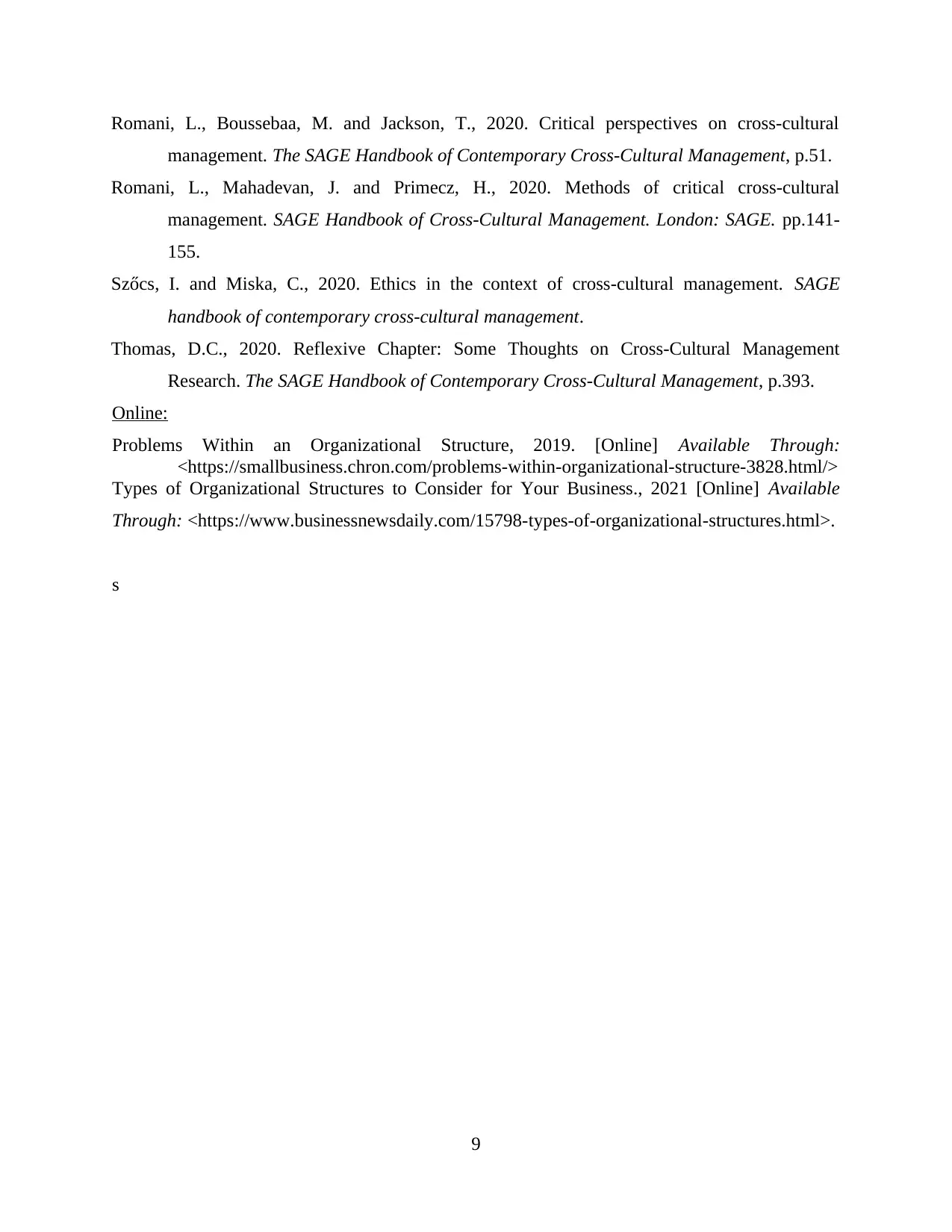
Romani, L., Boussebaa, M. and Jackson, T., 2020. Critical perspectives on cross-cultural
management. The SAGE Handbook of Contemporary Cross-Cultural Management, p.51.
Romani, L., Mahadevan, J. and Primecz, H., 2020. Methods of critical cross-cultural
management. SAGE Handbook of Cross-Cultural Management. London: SAGE. pp.141-
155.
Szőcs, I. and Miska, C., 2020. Ethics in the context of cross-cultural management. SAGE
handbook of contemporary cross-cultural management.
Thomas, D.C., 2020. Reflexive Chapter: Some Thoughts on Cross-Cultural Management
Research. The SAGE Handbook of Contemporary Cross-Cultural Management, p.393.
Online:
Problems Within an Organizational Structure, 2019. [Online] Available Through:
<https://smallbusiness.chron.com/problems-within-organizational-structure-3828.html/>
Types of Organizational Structures to Consider for Your Business., 2021 [Online] Available
Through: <https://www.businessnewsdaily.com/15798-types-of-organizational-structures.html>.
s
9
management. The SAGE Handbook of Contemporary Cross-Cultural Management, p.51.
Romani, L., Mahadevan, J. and Primecz, H., 2020. Methods of critical cross-cultural
management. SAGE Handbook of Cross-Cultural Management. London: SAGE. pp.141-
155.
Szőcs, I. and Miska, C., 2020. Ethics in the context of cross-cultural management. SAGE
handbook of contemporary cross-cultural management.
Thomas, D.C., 2020. Reflexive Chapter: Some Thoughts on Cross-Cultural Management
Research. The SAGE Handbook of Contemporary Cross-Cultural Management, p.393.
Online:
Problems Within an Organizational Structure, 2019. [Online] Available Through:
<https://smallbusiness.chron.com/problems-within-organizational-structure-3828.html/>
Types of Organizational Structures to Consider for Your Business., 2021 [Online] Available
Through: <https://www.businessnewsdaily.com/15798-types-of-organizational-structures.html>.
s
9
1 out of 11
Related Documents
Your All-in-One AI-Powered Toolkit for Academic Success.
+13062052269
info@desklib.com
Available 24*7 on WhatsApp / Email
![[object Object]](/_next/static/media/star-bottom.7253800d.svg)
Unlock your academic potential
Copyright © 2020–2025 A2Z Services. All Rights Reserved. Developed and managed by ZUCOL.





